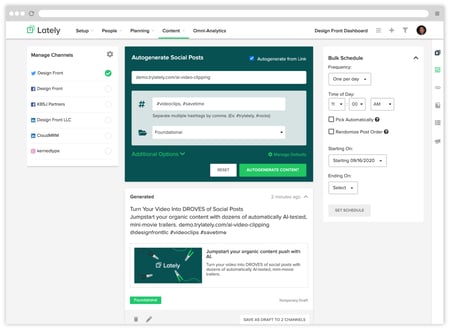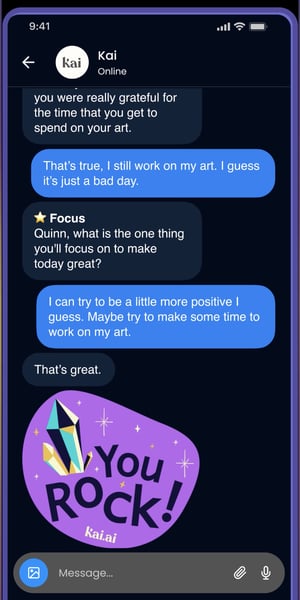 Nearly all the buzz about AI in the past several months has been around using AI tools like ChatGPT for text and Dall-E for images to access and organize data found on the public Web. Far more interesting to me, and where billions is being invested by VCs right now, is how AI works with proprietary content.
Nearly all the buzz about AI in the past several months has been around using AI tools like ChatGPT for text and Dall-E for images to access and organize data found on the public Web. Far more interesting to me, and where billions is being invested by VCs right now, is how AI works with proprietary content.
There are many ways that businesses can tap the potential of AI to work with data that they own. I’ve been using AI, including tools from Lately.ai and ChatGPT, to help me with my augment my own writing. As well, there are many companies using AI to manipulate their own data and sell that as a product to customers. I’ll share examples of both.
This post, part of a series I’m writing during the month of February, will look at just a few ways to tap AI right now. Here is last week’s post: Generative Artificial Intelligence and the Future of Marketing.
How ChatGPT can augment writing
I use ChatGPT for things like summarizing a long article I’ve written into one paragraph or turning that same article into a bulleted list of takeaways.
I can drop in a speech abstract and ask the AI to create a few kickoff questions for a moderator to ask during the Q&A after my speech.
To create the headline of this blog post, I entered the first paragraph of the post into ChatGPT and with a prompt to create a blog post headline and this was what came back: "Unlocking the Potential of AI with Proprietary Content: The Future of Investment". Not perfect, but it was helpful for me to then edit that suggestion rather than craft a headline from scratch.
Lately.ai turns my books and blogs into social content
 I’m a writer. I’ve written or co-written 13 books, a dozen or so eBooks, around 100 magazine articles, and something like 1,500 blog posts. Every single one of those has potential for sharing on my social networking accounts, especially Twitter and LinkedIn.
I’m a writer. I’ve written or co-written 13 books, a dozen or so eBooks, around 100 magazine articles, and something like 1,500 blog posts. Every single one of those has potential for sharing on my social networking accounts, especially Twitter and LinkedIn.
For more than two years, I’ve been using Lately.ai for exactly this purpose. I drop a book chapter or the link to a blog post into Lately.ai and it quickly generates short form text content that can be shared on my social feeds. What’s great about it is that it is my content and over two years Lately.ai has been trained on my voice!
I was so impressed with Lately.ai when I first saw it that I invested in the company and joined the advisory board.
My friend Kate Bradley Chernis, CEO of Lately.ai says: “OpenAI (ChatGPT) excels at creating large amounts of long form content from very minimal input, but the tone and voice of that content can't match the tone and voice of the user. Whereas Lately.ai applies what we refer to as a ‘style-transfer’ rewrite to modify longform content, so it is in the exact voice of the user. Lately's ability to break down the DNA of effective messaging and customize its learnings to any individual or brand gives it the ability to generate content it knows will have the maximum engagement and reach on social media. Our AI requires human training. We don't replace, we augment.”
Shutterstock AI Image Generator
It’s interesting that Shutterstock, a large stock photo provider where many marketers go to purchase photos to legally use for marketing has struck a deal with OpenAI to use their technology to generate new images from prompts. The key to the Shutterstock AI Image Generator is that the data set used to train the AI is all from licensed content.
To create the top image in this blog post, I used Shutterstock’s AI with the prompt “Colorful stylized drawing of a writer at work on a typewriter”. I feel more comfortable using images created from licensed images rather than from the public web so I will likely use this frequently.
In an upcoming post, I will look at some of the ethical and legal ramifications of AI.
Kai.ai for self-discovery and well-being
 For the past few days, I have been experimenting with Kai.ai, a conversational AI companion for self-discovery and well-being. The dataset that Kai.ai uses is proprietary content created by the company’s team of experts and validated by their human companions on actual conversation within Kai.ai. When it comes to important wellness and mental health communications, creating the content from experts, rather than from the public web is important.
For the past few days, I have been experimenting with Kai.ai, a conversational AI companion for self-discovery and well-being. The dataset that Kai.ai uses is proprietary content created by the company’s team of experts and validated by their human companions on actual conversation within Kai.ai. When it comes to important wellness and mental health communications, creating the content from experts, rather than from the public web is important.
Here’s what Emily Zaccardi, Head of Marketing at Kai.ai told me about how the service is used: “Young people message with Kai directly on iMessage, Discord, WhatsApp or telegram for ongoing reflection... It is not an app! Our mission is to help young people realize their potential in a healthy way. Why? The public health crisis in mental health is drastically affecting younger generations, and most of the places they spend time online don't help them develop a critical sense of self-worth. (They often make it worse.) Last year, 100,000 young people voluntarily thanked Kai for helping them get through something in their life.”
If you want to dig much deeper into these ideas, check out the Marketing AI Institute, a media, event, and online education company making AI approachable and accessible to marketing and business leaders around the world.
Marketing AI Institute has a free, virtual AI for Writers Summit on March 30 that I am planning on attending.
Disclosures: I am investor in and an advisor to both Lately.ai and the Marketing AI Institute.